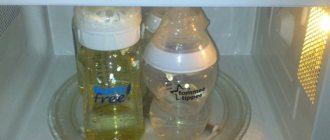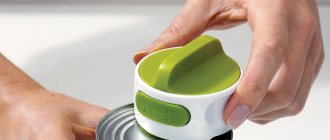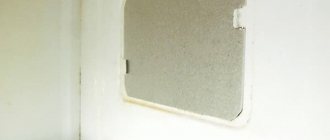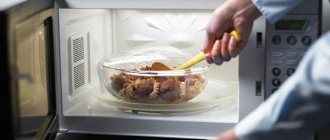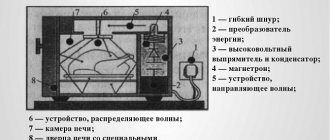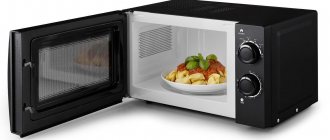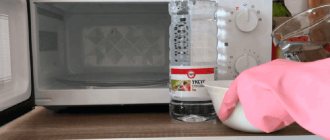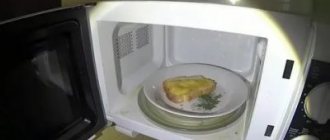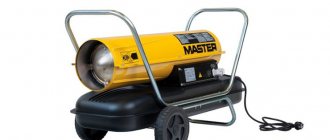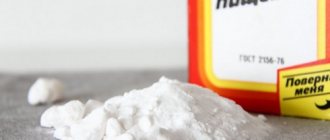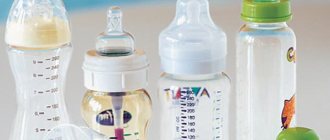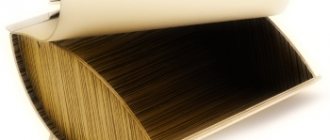Is it possible to sterilize glass jars in the microwave?
A microwave oven makes it possible to sterilize several jars at once in a few minutes. There are no prohibitions on the use of the unit; glass containers are allowed to be placed in the chamber; the microwave heating temperature is sufficient to eliminate bacteria.
Is it possible to sterilize empty jars in the microwave?
The microwave oven allows you to process containers without food inside. But it is not recommended to place completely empty, dry cans into the device chamber. To carry out sterilization, you need to pour a little water into them or place a separate container with liquid nearby so that hot steam is formed under the influence of radiation.
At what temperature should jars be sterilized in the microwave?
The temperature at which food and empty containers are processed in a microwave oven depends on the power setting. With an indicator of about 800 W, the unit will quickly heat water in a glass container to 100 °C.
At boiling temperature, hot steam is generated in the microwave oven, which ensures disinfection
How to pour jam into sterilized jars
After the jars and lids are ready to be filled with jam, the problem arises of whether to pour the delicacy into the container hot or cold. It is recommended to place berries boiled in syrup until tender into sterilized, not cooled vessels. “Five Minutes” brought to a boil according to the recipe is also poured hot and immediately rolled up with either a tin lid or a twist-off.
When the jam boils for up to half an hour, it is better to cool it first before putting it in a glass container, also cooled after sterilization.
How many minutes does it take to sterilize jars in the microwave?
The duration of heating the cans in the microwave depends on their volume. The larger the container, the longer it needs to be kept inside the chamber.
How long does it take to sterilize empty jars in the microwave?
Typically, the process of sterilizing unfilled jars takes about six minutes. But in each case, the time is determined individually; it is necessary to monitor when the water boils in the container.
How long to sterilize half-liter jars in the microwave?
One small 0.5 liter jar can be placed in the microwave for just two minutes. If there are several containers, the time is increased to 3-4 minutes.
Sterilization process
The easiest way to disinfect jars is to expose them to high temperature water vapor. It completely envelops glass containers from the inside, destroying bacteria, fungi and viruses.
The sequence of actions is as follows:
- You need to pour clean water into the jars so that the bottom is covered by 3 centimeters. It is advisable to take distilled or settled liquid so that during sterilization a metallic deposit does not form on the container.
- Place the jars on the tray of the microwave oven. Make sure that they do not touch each other's walls.
- Set the microwave to 800 watts and press the start button.
How long does it take to sterilize glassware? This depends on the load level of the microwave oven and the volume of the container. It is enough to soak 3-4 half-liter jars for 3 minutes.
A 3-liter jar is sterilized for 4-5 minutes, after pouring half a mug of water into it and placing it on the tray sideways so that the liquid does not leak out.
We recommend: Which windows are better - plastic or wooden?
Preparing jars for sterilization
Before quickly sterilizing jars in the microwave, they need to be prepared. Namely:
- wash thoroughly with soda, mustard powder or regular dish gel, using a brush if necessary;
- pay special attention to the bottom and necks; contaminants most often remain in these places;
- rinse and dry the jars naturally on a towel;
- inspect the container and make sure there are no cracks or chips.
Damaged jars may burst in the microwave during the high-heat sterilization process. In addition, it is unsafe to store food in them; the seal will be incomplete, and accordingly, the products are likely to deteriorate ahead of schedule.
How to properly sterilize empty jars in the microwave
The classic algorithm suggests steaming jars in the microwave using water. But if you need dry containers, you can use another method. It looks like this:
- Pour clean water into a small glass glass, leaving about 4 cm to the edge;
- place the container in the center of the plate in the microwave;
- glass jars that need to be sterilized are placed empty around them;
- set the power to 750 W and put the unit into operation for five minutes.
The microwave oven will heat the liquid inside the glass, and due to this, the temperature in the chamber will rise to the desired values. At the end of the device’s operating cycle, the dry containers are removed and canning begins immediately.
Important! It is necessary to remove dishes from the oven after sterilization using oven mitts. If you handle it with bare hands, you may get burned.
How to sterilize 3-liter jars in the microwave
Not every microwave oven is suitable for sterilizing large 3-liter jars. It is necessary to ensure that the container actually fits inside the unit.
Typically, a 3 liter jar only enters the microwave in a horizontal position. Therefore, the processing is carried out like this: a little water is poured into the dishes, and then placed horizontally in a deep plate.
Place a plate under a large jar to prevent it from rolling around the chamber
Ideally, the liquid should not spill out of the jar, but even if this happens, it will not leak directly onto the glass stand. The sterilization process itself is standard - you need to set the power to about 800 W and start the microwave oven for 5-6 minutes.
How to sterilize liter jars in the microwave
It is easiest to process 1 liter containers in the microwave. To sterilize containers, just fill them with 2-3 cm of clean water, and then place them in the device chamber at a short distance from each other. The oven is put into operation for two minutes if there is only one can, and for five minutes if there are several of them at once.
How to sterilize jars of water
The classic algorithm for sterilizing jars in a microwave oven looks like this:
- Pour a little water into clean and pre-dried containers, no more than 3 cm from the bottom. It is better to take filtered liquid so that limescale does not form.
- The jars are placed in the microwave oven so that they do not touch each other or the walls of the chamber. The unit plate should rotate freely.
- In the microwave oven settings, the power is set to about 800 W and the time is set from two to six minutes, depending on the volume and quantity of containers.
- Turn on the microwave and wait for the water to boil. After this, you need to keep the jars inside the device for another 1-2 minutes to ensure steam disinfection is as effective as possible.
At the end of the heating cycle, turn off the microwave oven and remove the glassware from the chamber using a tight potholder. The remaining water is drained, and the moisture on the bottom and walls is blotted with a sterile bandage or gauze.
Water becomes a conductor of heat in the microwave, so without it the dishes will simply remain cold
Important! It is recommended to start canning food immediately after finishing cooking the dishes in the oven.
It should be noted that jars with lids cannot be sterilized in the microwave. The latter may melt or spark under the influence of radiation. Metal and plastic lids are treated separately; it is best to simply put them in boiling water and leave for 15 minutes.
Do I need to sterilize jam and canning jars?
Containers for canning vegetables and berries must be perfectly clean and sterile. Even slight dirt will become a breeding ground for pathogenic microorganisms. You can’t keep jam in unwashed containers: it will ferment, become moldy, and you can’t eat it.
Even if you twist the jam for five minutes under iron lids, the dessert will spoil in dirty jars and you will have to destroy it.
Those sweet preparations that contain enough sugar and boil them for 15 to 30 minutes do not require special sterilization.
In this case, you can get by by rinsing the cans of soda.
How to sterilize jars in the microwave with preparations
Some recipes suggest sterilizing jars in a microwave oven not before canning, but at the final stage of the procedure, when the jars are already inside. This processing method allows not only to eliminate microorganisms from the surface of the container, but also to reliably disinfect the products themselves. Most often, mushrooms, vegetables and fruits are subjected to sterilization, in the preparation of which vinegar and other food preservatives were not used.
A microwave oven allows you to process filled dishes at high temperatures without harming the workpiece. This method even has additional advantages. Under the influence of radiation, it is not the container itself that is heated, but rather the liquids inside it; accordingly, sterilization of workpieces in the microwave will be doubly effective. The advantage is that processing does not take much time. The desired temperature in the oven will be reached in a few minutes, and the taste of the food will not change, as could happen with prolonged heating.
How to sterilize jars of salads and pickles in the microwave
Processing in a microwave oven extends the winter storage period of salads and pickles, prevents the products from spoiling prematurely and does not affect the taste. Sterilization is carried out according to the following algorithm:
- clean dishes are filled with food - not up to the neck, but about 2/3 of the total volume;
- place the jars in the microwave one at a time or several at a time, the containers should not touch each other;
- set the power to about 750 W;
- set the processing time; if salads and pickles are to be sterilized in a 1 liter container, heating for three minutes will be sufficient;
- close the chamber and turn on the microwave oven.
The video on how to properly sterilize jars in the microwave notes that you do not need to cover them with lids. After the sound signal, the device is not opened immediately, but the containers are allowed to stand for about five minutes. Then the dishes are carefully removed with oven mitts, placed loosely on top of the lid and left on the table until cooled. When the workpieces have cooled, all that remains is to fill the container to the end and seal it hermetically.
If the cans are filled almost to the top, it is better to put them in trays, the liquid will splash out
How to sterilize jam jars in the microwave
You can disinfect jars in the microwave for the winter along with jam. The procedure is carried out as follows:
- Place fresh jam in the container, leaving about 5 cm from the neck so that when boiling the delicacy does not leak over the edges;
- without lids, the jars are placed in a microwave oven and positioned so that they do not touch each other or touch the walls of the chamber when the plate rotates;
- set the power for the microwave to about 700-750 W;
- put the device into operation for 6-8 minutes.
At the end of the heating cycle, the chamber door is not opened immediately, but after five minutes. The hot dishes are removed from the microwave and allowed to cool slightly, after which they are tightly wrapped for the winter and stored.
How to sterilize jars of fruits and berries
Kitchen appliances allow you to quickly and effortlessly pasteurize jars in the microwave along with berries and fruits. The processing is usually carried out in sweet syrup, and the scheme looks like this:
- washed and dried fruits are placed in containers, leaving a few centimeters to the neck;
- prepare simple sugar syrup and pour it over berries or fruits up to about half the container;
- place the jars inside the microwave oven and set the maximum power;
- turn on the unit for 3-5 minutes depending on the size of the dishes;
- After the sound signal, wait another five minutes and remove the containers.
After the dishes have cooled a little, you will need to add the syrup to the end, seal the preparations hermetically with sterile lids and leave them on the table under towels until they cool completely.
Important! It is recommended to turn the containers upside down during the cooling process to ensure that there are no leaks.
Advantages and disadvantages of sterilizing jars in a microwave oven
High-temperature processing of cans in a microwave oven has its advantages and disadvantages. The procedure has several advantages:
- Sterilization takes only a few minutes and can be completed faster than using an oven or water bath.
- When using a microwave, the microclimate in the kitchen does not change, the temperature does not rise and no fumes are formed.
- You can put several small jars at once in the microwave, whereas on the stove you usually have to process them one at a time.
- If you follow basic safety rules, there is virtually no risk of getting burned. Removing hot cans from the microwave is not much more difficult than removing a plate of heated food.
If you carefully inspect containers before placing them in a kitchen appliance, sterilization will not harm the glassware in any way.
Dishes in a microwave oven can only burst if there are cracks in them to begin with.
At the same time, disinfecting containers in the microwave has certain disadvantages:
- The capacity of a kitchen appliance is usually small - it will not be possible to process a large number of cans in one go.
- A microwave oven is best suited for sterilizing 0.5-1 liter jars; bulk containers are simply not included in most models.
- Processing dishes requires electricity, while heating containers on the stove or in the oven is usually more economical.
In general, sterilization in the microwave has many more advantages. If you need to disinfect small containers, then using a kitchen device will be convenient.
Sterilization of jars with blanks
If housewives doubt that the product prepared for the winter will last a long time, then they pasteurize the jars containing the preserved food. It should be remembered that the containers are only covered on top with metal lids, without being rolled up.
In a saucepan
Glass vessels filled with jam are placed in a pan with a piece of canvas placed at the bottom. Water is poured up to the shoulders of cans covered with lids. Place the pan on the fire. When the water boils, leave on the fire for 10 minutes for a half-liter container, 15 - liter, 20 - 2 and 3-liter.
Instead of a saucepan, for large-volume vessels, use an enamel bucket.
In the oven
The cabinet is often used in the sterilization of preserved jars. This method is especially convenient for small containers of jam. Place the jars on a wire rack or tray and cover with metal lids. You can preheat the oven slightly and place a tray inside.
The sterilization temperature should be 160-180 degrees.
To prevent jam from getting to the bottom of the oven, you must not pour it into a container with a top.
See also
4 best recipes for making clear cinnamon apple jam in slices for the winter
Read
